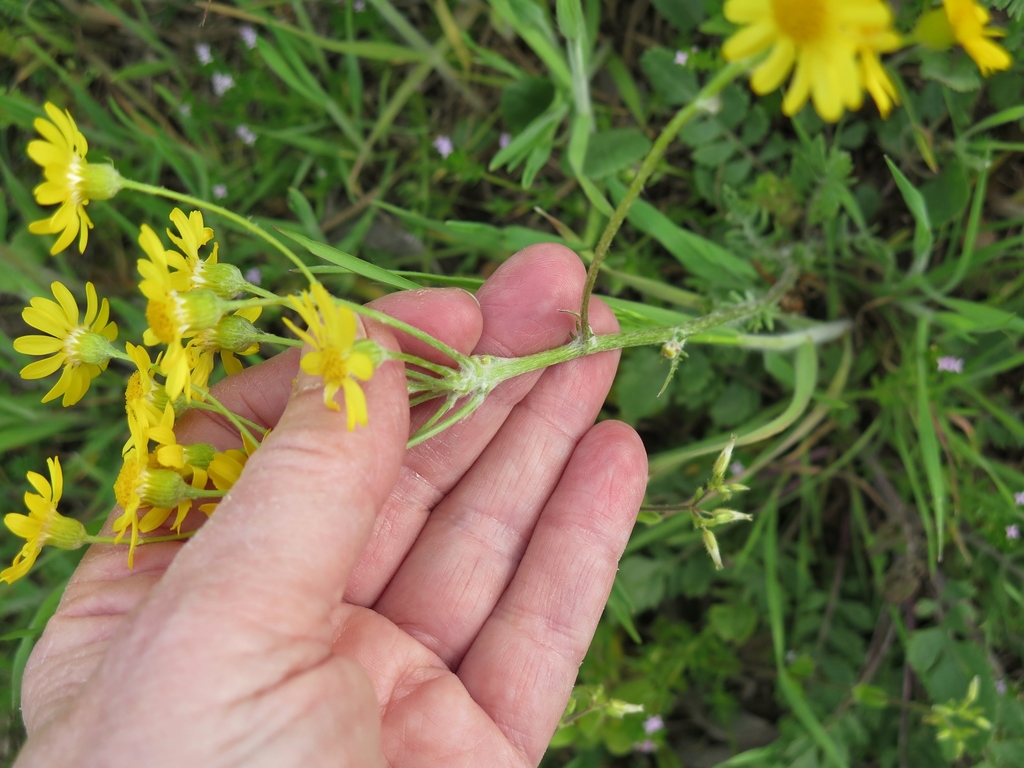Packera and Senecio (Groundsels and Ragworts)
This is one of those groups where I can remember the Latin name more easily than the common name. I think Packera is easier to remember than groundsel. I remember getting a pretty good handle on these in 2019, but after not thinking about them since early spring almost a year ago, I couldn’t remember what the differences were! So, it was back to the big book (Flora of North Central Texas) to sort it all out AGAIN. I thought I’d write it down this time, just in case I’ve forgotten by the time these roll around next spring (which seems more than likely!)
There are two Senecio species to be found around nc TX:
S. ampullaceus (Texas Groundsel) and S. vulgaris (Common Groundsel). These two are distinguished from the Packera species by their clasping leaves. I have never observed Texas Groundsel, but the S. vulgaris is very common – hence the name, I guess!(1) S. vulgaris: ray flowers usually missing, leaves pinnately lobed, phyllaries black-tipped. (COMMON GROUNDSEL)

(2) S. ampullaceus: ray flowers prominent, leaves shallowly toothed, phyllaries green-tipped (TEXAS GROUNDSEL)
There are four Packera species found in nc TX.
The first two Packera species have their largest leaves crowded near the base, and upper leaves greatly reduced and often different in shape from lower leaves. Both are fairly common here.
(1) P. obovata: blades of basal leaves are round (< 1.5 times as long as wide), plants glabrous except in leaf axils, inflorescence WITHOUT woolly pubescence; basal leaves usually purple on the underside. (GOLDEN GROUNDSEL, ROUNDLEAF RAGWORT)

(2) P. plattensis: blades of basal leaves oblong:(> 1.5 times as long as wide) plants unevenly woolly pubescent: Very unevenly woolly when young, and with at least some woolly pubescence at the nodes of the inflorescence even when mature. Basal leaves usually green on the underside, but may have some purple. (PRAIRIE GROUNDSEL)


The final two Packera species have leaves that are pinnately compound or very deeply lobed, fairly evenly distributed along the stem (not crowded at the base,) and basal and stem leaves are similar in shape. Neither of these have wooly pubescence.
(1) P. tampicana: lateral lobes of lower and middle stem eaves often contracted to very narrow linear basal that attaches to the midrib. Weedy in low prairies ,disturbed areas, roadsides. Typically in open places. (GREAT PLAINS
RAGWORT, YELLOWTOP)

(2) P. glabella: Rare in nc TX, mainly se and e TX. (BUTTERWEED)

BACK TO: A Collection of Helpful Identification Guides







Comments
@lisa281 Oh my. Two different genera? That might explain why the two groups of "groundsels" in my garden are behaving quite differently. I will have to check later this morning.
Add a Comment